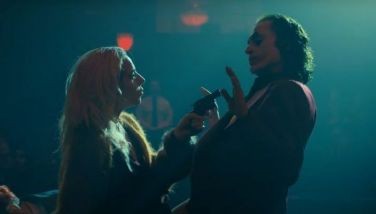Mario O’Hara: Under-rated or over-the-hill?
 He always gave such a riveting performance onstage that we tried to watch him whenever we could. Last year, he was the frustrated playwright in Belong Puti from PETA; this year, a nation’s President thrown into prison by a coup in Kudeta from Tanghalang Pilipino (currently running at the CCP until Feb. 3). In both plays, Mario O’Hara made us laugh so hard until we realized the situations weren’t really funny, and were, in fact, dismal.
He always gave such a riveting performance onstage that we tried to watch him whenever we could. Last year, he was the frustrated playwright in Belong Puti from PETA; this year, a nation’s President thrown into prison by a coup in Kudeta from Tanghalang Pilipino (currently running at the CCP until Feb. 3). In both plays, Mario O’Hara made us laugh so hard until we realized the situations weren’t really funny, and were, in fact, dismal.
As we strode along the restaurant row fronting the CCP, Mario pointed to the murky water hidden by bright lights around and in the distance. “This is where I shot Babae sa Breakwater, “ he says of the much-acclaimed 2004 official selection to the Cannes Film Festival Directors Fortnight, O’Hara’s latest directorial work. The film that dealt with the hand-to-mouth existence of people living around the breakwater of Manila Bay won raves abroad and brought attention to lead Katherine Luna.
Soon, however, Katherine took the path of most showbiz denizens — forgotten and forlorn — while its director O’Hara would happily return to acting while brewing yet another film project in his mind. Mario seemed to have this knack of turning things around easily. What is done is done, no need to dwell on the past. There is always the future to look forward to. And yet, this simplistic happy view of life seems to go counter to what the audience experiences in his films. He sets many of his works in a prison-like setting which its inhabitants — prostitute, ex-convict, retardate, drunkard, drug taker, the mistress — can either accept or fight. He is a master of the grim and violent which he exploits to perfection in his horror and action movies (Kastilyong Buhangin, Condemned, Bagong Hari, Pangarap ng Puso). He takes risks in everything he does, opting for the cutting edge instead of the safe sober path, and finding humor beneath the darkest stories of mankind in his writings and directions.
Many who have met him describe him as weird and snob. The most overused adjective we’ve encountered in reference to Mario has been underrated. Laughing loudly, he objects saying, “Hindi. Sabi nila over-the-hill na daw ako.”
An Adamson University dropout in Chemical Engineering, Mario got into radio at age 17 doing radio dramas, which he found fulfilling enough to stop schooling. It was at DZRH where his friend and collaborator Lino Brocka met him and that began Mario’s venture into theater, TV and the movies.
Brocka formed the Cinemanila film company with friends, and came out in 1974 with Tinimbang Ka, Ngunit Kulang with Mario and Lolita Rodriguez heading the cast, plus the newcomer 17-year-old Christopher de Leon. This unlikely love story between a leper and a deranged woman became an instant success, and Mario was given his break as a director in Mortal, a psychological drama based on the true-to-life story of Anthony Villegas imprisoned for killing his wife.
That Mario should choose such a subject for his first film would be typical of his succeeding directorial projects. His sympathies lay with characters in the fringes of society, the downtrodden, the misunderstood, and the outcast whom he portrays and directs with such bravura and apparent empathy.
He tells us he has done every genre in film except comedy and musical but would be open to try both, recalling a one time project with Dolphy that fell through. We will not venture to guess, just how dark this comedy would be when it’s finally made.
While he can’t remember exactly how many films he has directed, he does recall, however, the cast, some pertinent details in the shooting and the year they were produced. And although he tells us that he is first an actor, second a writer, and lastly a director, one cannot at all ignore the films he has directed among which are some of the best in Philippine cinema.
Half of his films were with Nora Aunor; a lot of them under the Regal banner (Mario has repeatedly called Mother Lily the best producer he has ever worked with). His works include Tatlong Taong Walang Diyos (1976) which gave Nora her first Urian trophy, Kastilyong Buhangin, and Halimaw sa Banga (1980), Bakit Bughaw ang Langit (1981), Gaano Ko Ikaw Kamahal (1982), Uhaw sa Pag-ibig (1983), Bulaklak sa City Jail (1984) Best Director at the MMFF, Bagong Hari (1986), Tatlong Ina, Isang Anak (1987), Johnny Tiñoso (1993), Fatima Buen (1994) Urian Best Director, Pangarap ng Puso (2000), Bulong ng Balakyot, Sisa, Condemned, Manananggal in Manila, Babae sa Bubungang Lata, Ngayon at Kailanman and Babae sa Breakwater.
Tatlong Taong Walang Diyos was produced during the much heralded Second Golden Age of Philippine Movies which also saw the likes of Eddie Romero’s Ganito Kami Noon Paano Kayo Ngayon; Mike de Leon’s Itim; Ishmael Bernal’s Nunal sa Tubig and Ligaw na Bulaklak; Lino Brocka’s Insiang (with screenplay by Mario); and Lupita A. Concio’s Minsa’y Isang Gamugamo. All these films were recognized and critiqued. Insiang won the 1976 Metro Manila Film Festival. Nora won her first Urian for Tatlong Taon which failed to be shown in the MMFF.
“Linaglag kami sa Festival,” says Mario matter-of-factly. The picture for the most part went unnoticed except for film buffs and Nora Aunor followers who marveled at its compassionate depiction of the Japanese invaders, and critic Noel Vera’s declaration of it being “arguably the greatest Filipino film ever made.”
Mario is proud of his meager body of work, never sorry for having done any of it. “Siguro nanghinayang lang,” he says, referring to the 1977 Metro Manila Festival entry Mga Bilanggong Birhen where he was replaced by producer Armida Siguion-Reyna with Romy Suzara. “Maganda ang script nun. Sayang,” sans rage or rancor.
Mario’s personal favorite, however, is Bakit Bughaw ang Langit where Nora plays an oppressed daughter made to care for a neighbor’s retardate son portrayed by Dennis Roldan. Noel Vera, perhaps the most consistent critic of Mario’s works, calls the film “one of the great unknown — perhaps lost — treasures of Philippine cinema.“ Isagani Cruz, on the other hand, compares the situation in the film with that in Brocka’s Bona and claims, “ In the comparison Brocka suffers. Where Bona fails, Bakit Bughaw ang Langit succeeds.”
But Mario is not one to dwell on the successes or failures of his projects, the what ifs and the wherefores of life. There are many more roles to play, many more films to shoot. He speaks of one pet project based on the Malay epic Bida Sari which he says would be the last Filipino film to be made, which would correct all the colonial misrepresentations in our history. Another would be the true story behind Nora’s skirmishes with drugs. “Pupuntahan ko si Guy sa America this year,” Mario shares.
Underrated, weird, over-the-hill? Perhaps a little of each, depending on who is speaking. For us, however, we see Mario as the ultimate Filipino filmmaker, stubborn survivor in the face of trials, the epitome of everything good and bad in the race, with the ability to find humor in the most miserable of human situations. Why are we a happy people when we are so poor and so exploited? Mario can answer that with a film.
(E-mail me at [email protected])
- Latest
- Trending
































